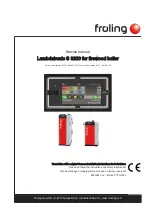
Installation 5
0020258610_00 ecoVIT exclusiv Installation and maintenance instructions
11
▶
Make sure that the existing gas meter is capable of
passing the rate of gas supply required.
▶
Check that the volumetric capacity of the expansion ves-
sel is sufficient for the system volume.
The safety cut-out installed in the product offers additional
low-water pressure protection to that provided by the water
pressure sensor.
The switch-off temperature for the product that arises as
a result of the fault is approx. 107 °C (nominal switch-off
temperature 107 °C, tolerance
−
6 K).
If plastic pipes are used in the heating installation, you must
install a suitable thermostat on-site on the heating flow. This
is required in order to protect the heating installation against
temperature-related damage. The thermostat can be con-
nected to the terminals for the surface-mounted thermostat
(blue Pro-E plug).
If non-diffusion-tight plastic pipes are used in the heating
installation, you must connect a plate heat exchanger for
system separation downstream in order to prevent corrosion
in the product.
Seals made of rubber-like materials may be subject to plastic
deformation, which can lead to pressure losses. We recom-
mend using seals made of a paste-like fibre material.
5.2
Required accessories (on-site)
The following required accessories (to be provided on-site)
are necessary for the installation:
–
Gas stopcock with fire protection device
–
Expansion relief valve, heating side
–
Service valves (heating flow and return)
–
Heating pump
–
Expansion vessel
–
Automatic air vent
–
Control
–
Air/flue pipe
On the VKK 476/4 and VKK 656/4 products, the 80/125
mm adapter (with test opening to measure the air/flue
gas) must be used.
Note
We recommend also using the 80/125 mm
adapter for the VKK 226/4 VKK 286/4 and
VKK 366/4 products to increase accessibility of
the measuring points.
5.3
Information on liquid gas operation
In the as-delivered condition, the product is preset for opera-
tion with the gas group indicated on the identification plate.
If you have a product that has been preset for operation with
natural gas, you must convert it to run on liquid gas. You will
need a conversion kit for this. The conversion procedure is
described in the manual supplied with the conversion kit.
5.4
Purging the liquid gas tank
If the liquid gas tank is not purged properly, this may result in
ignition problems.
▶
Ensure that the liquid gas tank has been purged properly
before installing the product.
▶
If required, contact the filler or the liquid gas supplier.
5.5
Using the correct type of gas
Using the incorrect type of gas may cause fault shutdowns in
the product. Ignition and combustion noise may occur in the
product.
▶
Only use the gas type listed on the identification plate.
5.6
Establishing the gas and water connections
5.6.1
Establishing the gas connection
Caution.
Risk of material damage due to the gas
leak-tightness test.
At a test pressure of >1.1 kPa (110 mbar),
gas leak-tightness tests may cause damage
to the gas valve assembly.
▶
If, during gas leak-tightness tests, you
also place the gas pipes and the gas valve
assembly in the product under pressure,
use a max. test pressure of 1.1 kPa
(110 mbar).
▶
If you cannot limit the test pressure to
1.1 kPa (110 mbar), close any gas stop-
cocks that are installed upstream from the
product before you carry out the gas leak-
tightness test.
▶
If, during gas leak-tightness tests, you
have closed the gas stopcock that is in-
stalled upstream of the product, relieve
the gas pipe pressure before you open
this gas stopcock.
1
▶
Remove the upper casing. (
→
Page 9)
▶
Install the gas pipe on the connection in the product
(1)
such that it is free from mechanical stress in accordance
with the generally recognised rules of good engineering
practice. To do this, use the compression fitting provided.
▶
Remove the residues from the gas pipe by blowing
through the gas pipe beforehand.












































